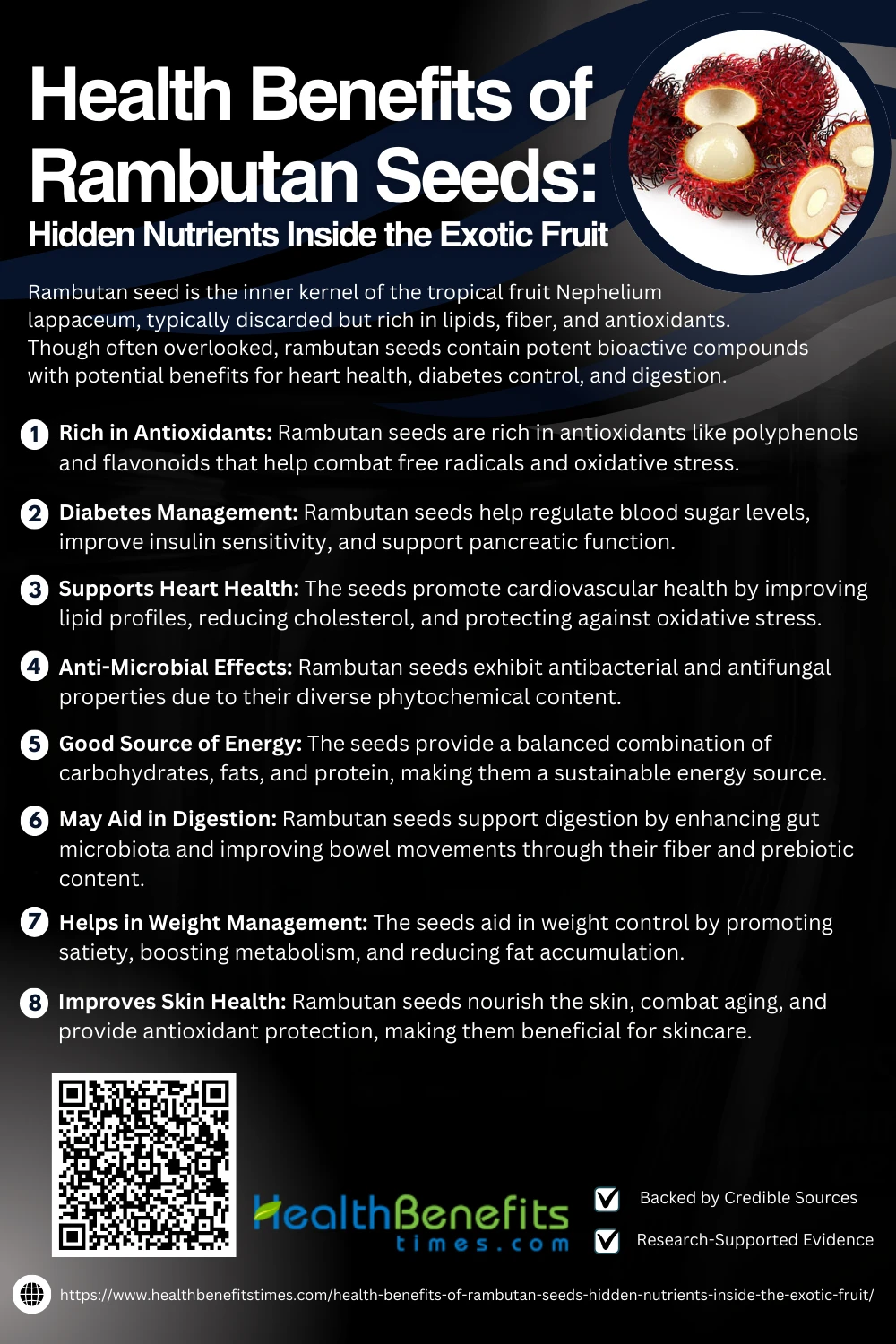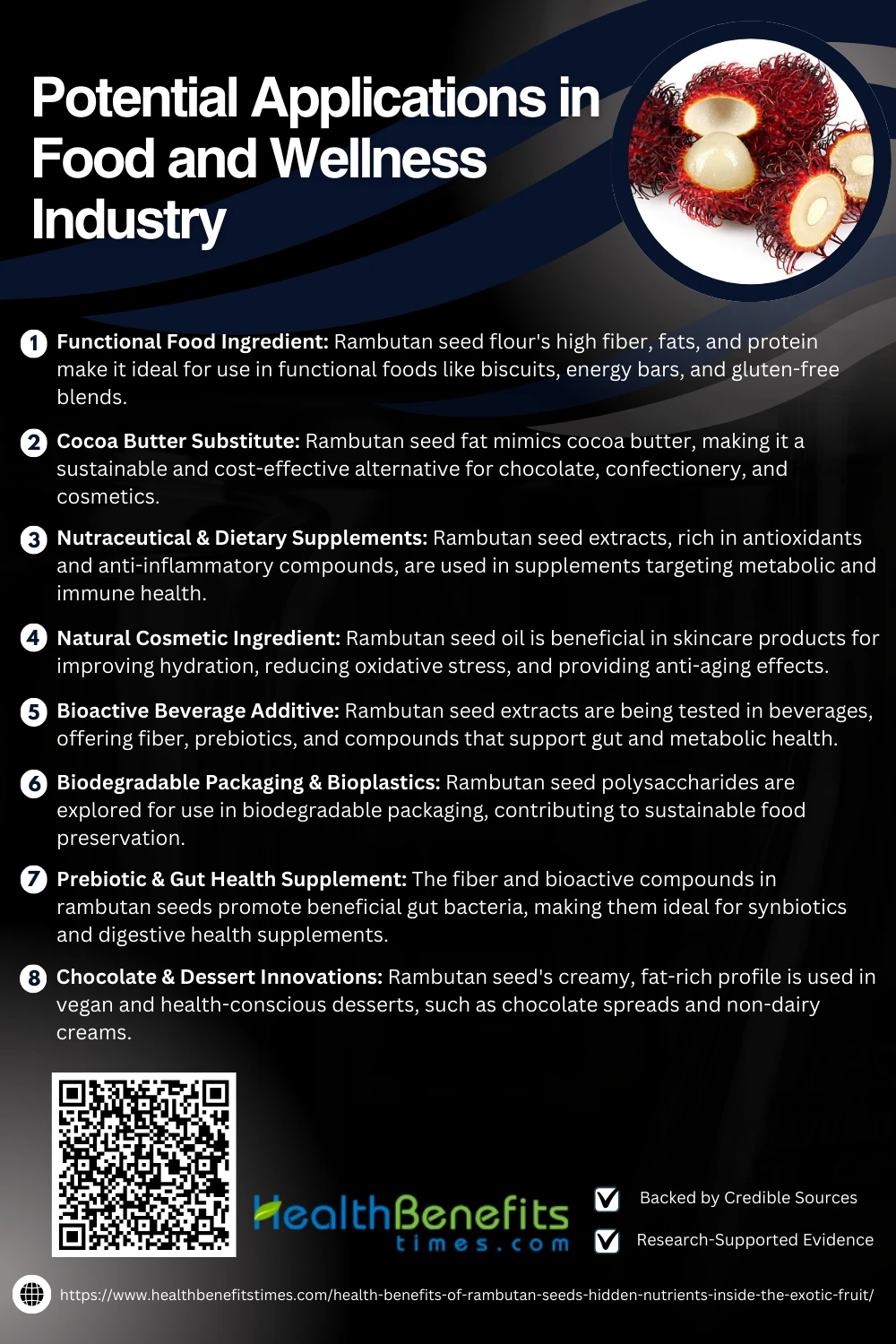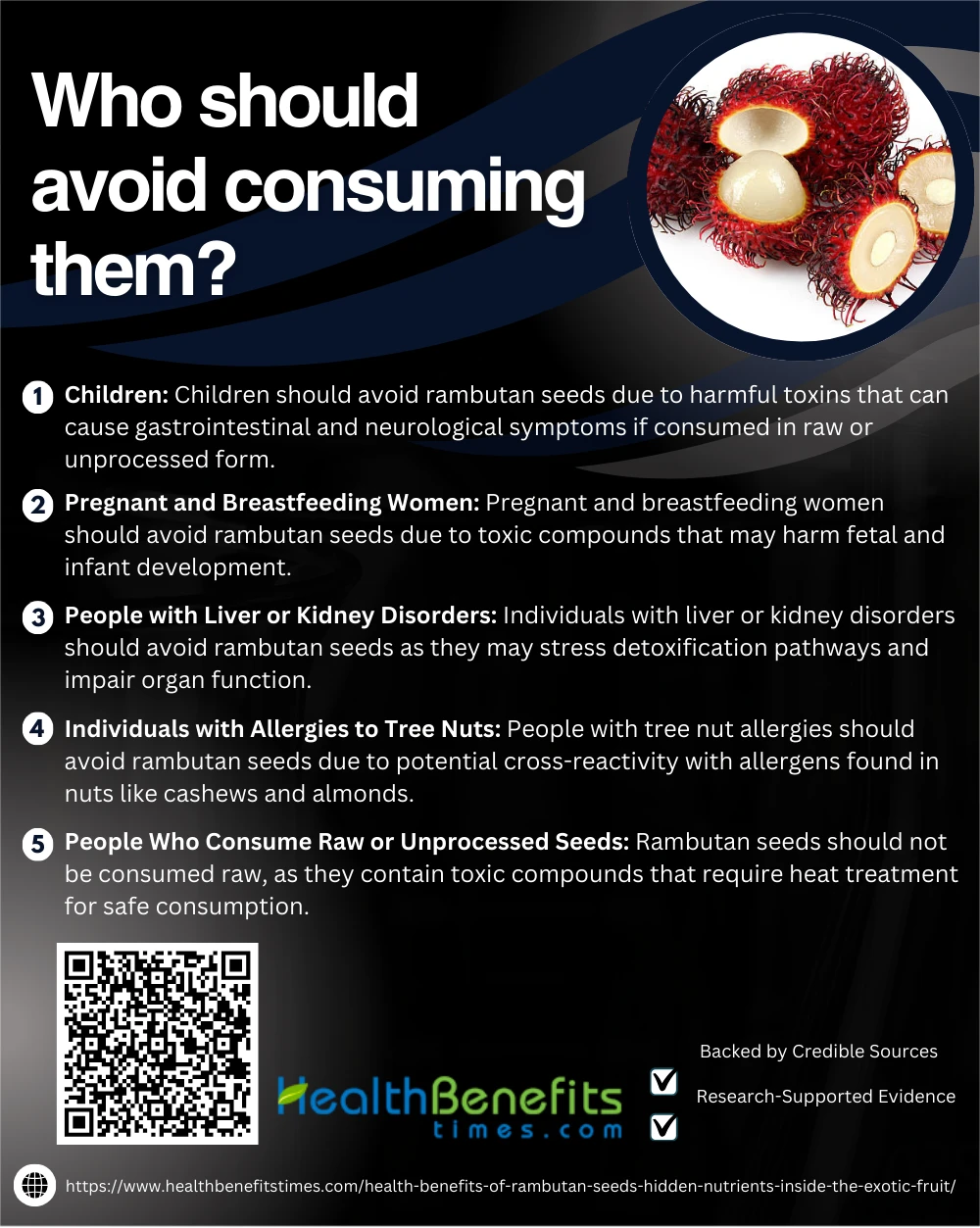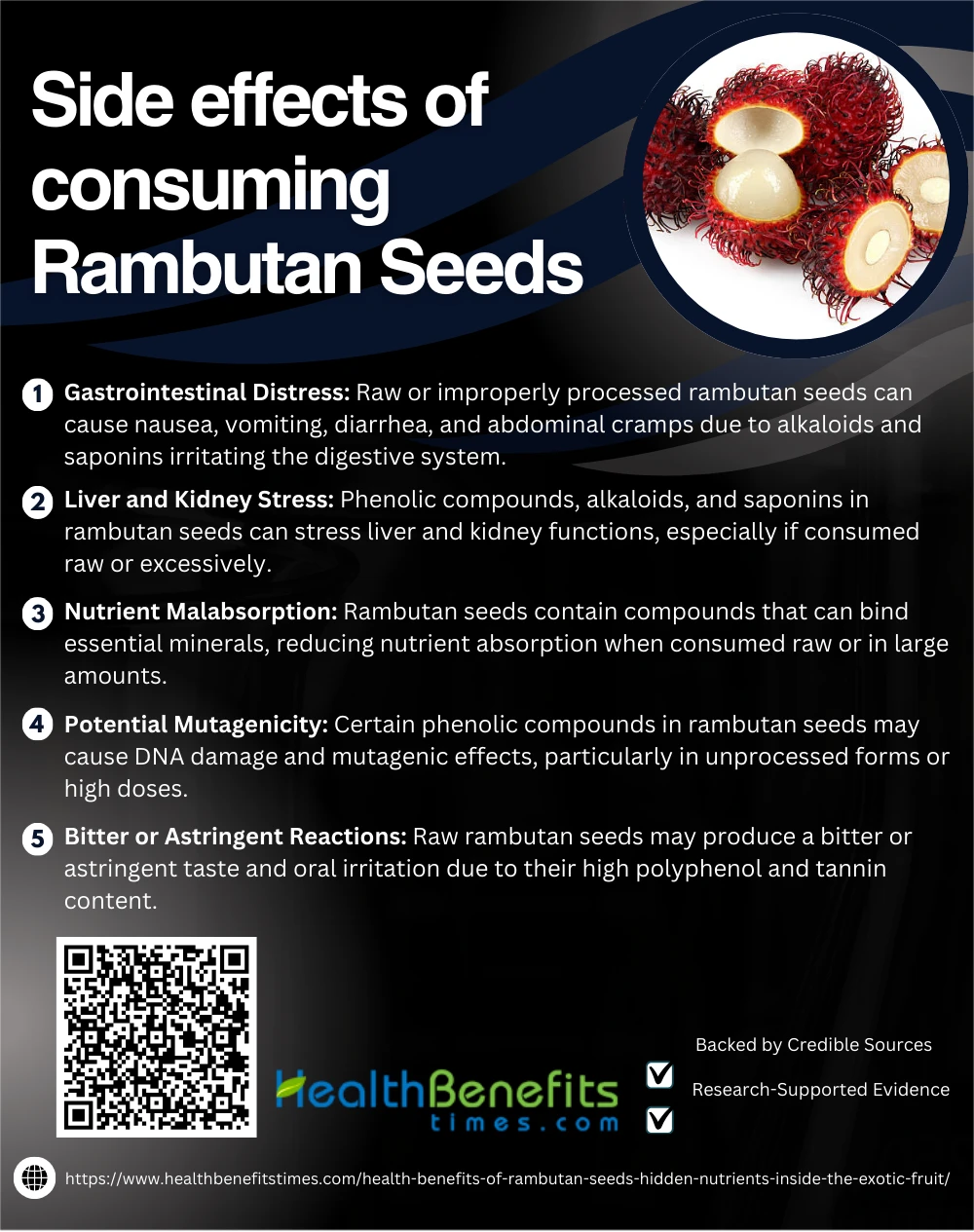- Rambutan seed is the inner kernel of the tropical fruit Nephelium lappaceum, typically discarded but rich in lipids, fiber, and antioxidants.
- Though often overlooked, rambutan seeds contain potent bioactive compounds with potential benefits for heart health, diabetes control, and digestion.
- Scientific studies reveal that with proper preparation, rambutan seeds may be transformed into functional food ingredients and natural wellness enhancers.
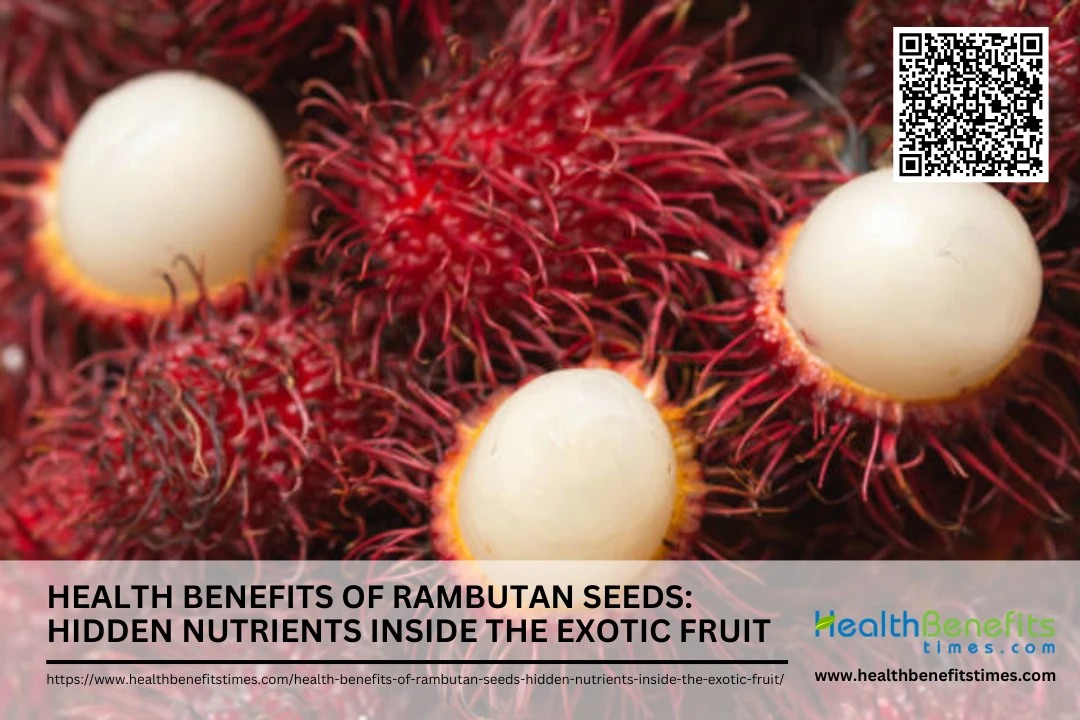 Rambutan seeds are the inner kernels of the tropical fruit Nephelium lappaceum, traditionally discarded but now gaining attention for their rich nutritional and phytochemical composition. These seeds are high in healthy fats, amino acids, and bioactive compounds.Once considered agricultural waste, rambutan seeds are now being studied for their surprising health benefits and potential applications in food and nutraceutical industries. Research shows that these seeds are rich in essential fatty acids, particularly oleic and arachidic acids, which may support cardiovascular health and reduce inflammation. Moreover, antioxidant compounds in rambutan seeds are being linked to anti-aging and disease-preventive properties, offering a promising source of natural health-boosting ingredients. With increased scientific validation, rambutan seeds are emerging from obscurity to become a key player in the field of plant-based health innovations.
Rambutan seeds are the inner kernels of the tropical fruit Nephelium lappaceum, traditionally discarded but now gaining attention for their rich nutritional and phytochemical composition. These seeds are high in healthy fats, amino acids, and bioactive compounds.Once considered agricultural waste, rambutan seeds are now being studied for their surprising health benefits and potential applications in food and nutraceutical industries. Research shows that these seeds are rich in essential fatty acids, particularly oleic and arachidic acids, which may support cardiovascular health and reduce inflammation. Moreover, antioxidant compounds in rambutan seeds are being linked to anti-aging and disease-preventive properties, offering a promising source of natural health-boosting ingredients. With increased scientific validation, rambutan seeds are emerging from obscurity to become a key player in the field of plant-based health innovations.
Nutritional Composition of Rambutan Seeds
Rambutan seeds, often overlooked, are surprisingly rich in essential nutrients. They contain healthy fats, protein, carbohydrates, and fiber, along with minerals and antioxidants that contribute to overall health and wellness.
1. Healthy Fats (30–40%)
Rambutan seeds are an abundant source of dietary lipids, particularly oleic acid (monounsaturated) and arachidic acid (saturated). These fats resemble cocoa butter in composition and are beneficial for cardiovascular health and skin repair. Oleic acid is known to help reduce bad cholesterol (LDL) while increasing good cholesterol (HDL).
2. Crude Protein (Up to 12%)
Rambutan seeds contain a decent amount of protein, especially for a plant byproduct. These proteins include essential amino acids such as leucine, valine, and phenylalanine, which are crucial for muscle synthesis, tissue repair, and immune response.
3. Dietary Fiber (8–12%)
Fiber in rambutan seeds helps regulate bowel movements, supports gut microbiota, and can slow glucose absorption, which is beneficial for blood sugar management. The seed flour form retains fiber even after processing, making it useful in health food formulations.
4. Ash Content (2–3%)
Ash represents the total mineral content after burning the organic matter. Rambutan seeds contain a mineral-rich profile including iron, zinc, calcium, and magnesium, which are vital for metabolic and enzymatic functions.
5. Moisture (5–10%)
The relatively low moisture content ensures shelf stability and microbial safety. This makes rambutan seed flour suitable for dry storage and incorporation into packaged health products.
6. Calcium
Calcium found in rambutan seeds supports bone mineralization, muscle contraction, and nerve transmission. Although not as high as dairy or leafy greens, it contributes meaningfully to daily intake when consumed in powdered or flour form.
7. Magnesium
This micronutrient is involved in over 300 enzymatic processes, including ATP production, muscle function, and nervous system regulation. Rambutan seeds supply moderate levels of magnesium, aiding in muscle recovery and energy levels.
8. Phosphorus
Essential for the formation of DNA, RNA, and cell membranes, phosphorus plays a major role in energy transfer via ATP. The phosphorus in rambutan seeds complements their fat and protein profile for overall metabolic support.
9. Natural Antioxidants
Rambutan seeds contain polyphenols, flavonoids, and tannins. These phytochemicals fight oxidative damage caused by free radicals, reducing the risk of chronic diseases like cancer, diabetes, and cardiovascular conditions.
10. Low Sugar Content
Unlike the sweet rambutan pulp, the seeds contain negligible sugar, making them ideal for low-glycemic diets. This makes the seed powder usable in diabetic-friendly formulations, high-protein snacks, and baking blends.
Comparison with other nut-like seeds (e.g., almonds, jackfruit seeds)
Here is a detailed nutritional comparison table between Rambutan Seeds, Almonds, and Jackfruit Seeds, focusing on their key components:
| Nutritional Component | Rambutan Seeds | Almonds | Jackfruit Seeds |
| Total Fat (%) | 30–40% (mostly oleic) | 49–55% (mostly MUFAs) | 0.4–0.8% (very low) |
| Protein (%) | 6–12% | 20–25% | 6–8% |
| Dietary Fiber (%) | 8–12% | 12–15% | 1.5–2.5% |
| Carbohydrates (%) | 45–50% | 20–22% | 35–40% |
| Calcium (mg/100g) | 60–80 mg | 260–270 mg | 50–60 mg |
| Magnesium (mg/100g) | 40–50 mg | 270–280 mg | 30–40 mg |
| Antioxidants (polyphenols) | Moderate | High | Low to Moderate |
| Sugar Content | Very Low | Low | Low |
Health Benefits of Rambutan Seeds
Beyond their tough exterior, rambutan seeds offer remarkable health benefits. Packed with antioxidants, healthy fats, and bioactive compounds, these seeds may support heart health, blood sugar control, digestion, and more.
Rambutan seeds are a potent source of antioxidants due to their high levels of polyphenols, flavonoids, and other bioactive compounds. These compounds contribute to strong free radical scavenging activity, as demonstrated in comparative analyses of tropical fruit by-products. Studies show that rambutan seed extracts exhibit significant antioxidant potential comparable to known natural sources Kaptso et al., 2022. (1) Advanced phytochemical profiling further confirmed the presence of ellagitannins and rutin-equivalent flavonoids in the seed matrix Mahmood et al., 2018. (2) Other researchers quantified phenolic content contributing directly to antioxidant activity Yunusa et al., 2018, while broader functional evaluations reinforced their role in oxidative stress mitigation Nguyen et al., 2025. (3) (4)
2. Diabetes Management
Rambutan seeds exhibit promising antidiabetic properties due to their ability to inhibit α-glucosidase enzymes and regulate insulin responses. Studies confirm that extracts from the seeds reduce blood glucose levels and improve pancreatic β-cell function Sapindaceae Nutraceuticals – ResearchGate (2024). (5) The seed’s phenolic compounds also enhance insulin sensitivity Academia.edu – Hamzah et al. (2018). Additional trials found improved oxidative balance and insulin response in diabetic mice IJMFMAP (2021). (6) Research on their inhibitory role in adipogenesis reinforces metabolic benefits Academia – Widowati et al. (2015). (7) Finally, antioxidant-rich rambutan peels and seeds offer synergistic support in controlling postprandial sugar spikes MDPI – Ma et al. (2017). (8)
3. Supports Heart Health
Rambutan seeds contribute to cardiovascular well-being due to their rich oleic and arachidic acid content, which can improve lipid profiles and reduce bad cholesterol Hamzah et al., 2018. (9) Research has demonstrated their role in reducing lipid peroxidation and protecting cardiac tissue from oxidative stress Akter & Rabeta, 2021. Their antioxidant richness helps mitigate atherosclerosis Sundar et al., 2024. (10) In diabetic models, they also showed potential in reducing heart-related risk factors Chandra et al., 2024. (11) The nutritional synergy of fats and polyphenols makes them a natural ally for cardiac health Sarkar et al., 2023. (12)
4. Anti-Microbial Effects
Rambutan seeds have demonstrated antibacterial and antifungal activities due to their diverse phytochemical constituents such as tannins, saponins, and phenolics. Methanolic seed extracts inhibit various human pathogens including E. coli and P. aeruginosa Sulistiyaningsih et al., 2018. Studies also report effective antimicrobial action from seed microemulsions Sriamornsak et al., 2023. (13) Rambutan peels and seeds both exhibit this property synergistically Mittraparp-Arthorn et al., 2022. (14) Evaluations confirm its effect against drug-resistant strains Handayani et al., 2021 and Rajasekaran et al., 2013. (15)
5. Good Source of Energy
Rambutan seeds are energy-dense, providing a rich combination of carbohydrates (up to 50%), healthy fats (30–40%), and moderate protein (6–12%) — making them a sustainable plant-based energy source. Their caloric value is comparable to common nuts and legumes Mahmood et al., 2018. (2) Studies highlight their balanced macronutrient profile for functional food use Biswas et al., 2021. (16) The oil-rich seeds also contain efficient fatty acids Cui et al., 2024, yielding high metabolic energy Afzaal et al., 2023. (17) (18) Their seed flour has even been incorporated into high-calorie food innovations Miranti & Wahini, 2021. (19)
6. May Aid in Digestion
Rambutan seeds contain a significant amount of dietary fiber and prebiotic compounds, which support digestive health by enhancing gut microbiota and regulating bowel movement. Research confirms that these fibers promote beneficial bacteria activity and improve nutrient absorption in animal models Ayob et al., 2025. (20) Additional findings reveal that fermented rambutan seed supplements optimize enzymatic digestion Wanapat et al., 2024. (21) Their prebiotic effects are linked to enhanced gastrointestinal resilience Akter & Rabeta, 2021. (22) In vitro assessments also demonstrated improvements in colonic fermentation and fiber digestibility John et al., 2025. (23) Emerging studies suggest they may help in managing digestive inflammation too Le Xuan et al., 2022. (24)
7. Helps in weight management
Rambutan seeds contribute to weight regulation through a synergy of dietary fiber, healthy fats, and bioactive compounds that support satiety and fat metabolism. The fiber increases fullness and delays gastric emptying Afzaal et al., 2023, while oleic acid improves lipid oxidation Miranti & Wahini, 2021. (19) (18) Bioactive phytochemicals also show anti-adipogenic effects in lab models Sundar et al., 2024. (10) Additionally, rambutan seed flour enhances metabolism when incorporated into food John et al., 2025 and helps reduce body weight in obese animal models Tripathi et al., 2021. (6) (23)
8. Improves Skin Health
Rambutan seeds are emerging in dermatological research for their anti-aging, antioxidant, and moisturizing properties. The seed oil is rich in oleic and arachidic acids, which nourish the skin and support barrier repair Cui et al., 2024. (17) Their natural antioxidant compounds like ellagitannins help fight oxidative stress in skin cells Mahmood et al., 2018. (2) Formulations using rambutan extract have shown visible anti-wrinkle effects Sekar et al., 2017. (25) Their use is expanding in natural skincare and sunscreen products Mota et al., 2020, and even in bioactive cosmeceuticals for UV protection Sekar, 2020. (26) (27)
How to Use Rambutan Seeds Safely
While rambutan seeds are nutritious, they must be prepared properly to avoid toxicity. Cooking methods like boiling or roasting help neutralize harmful compounds, making the seeds safe and beneficial for consumption.
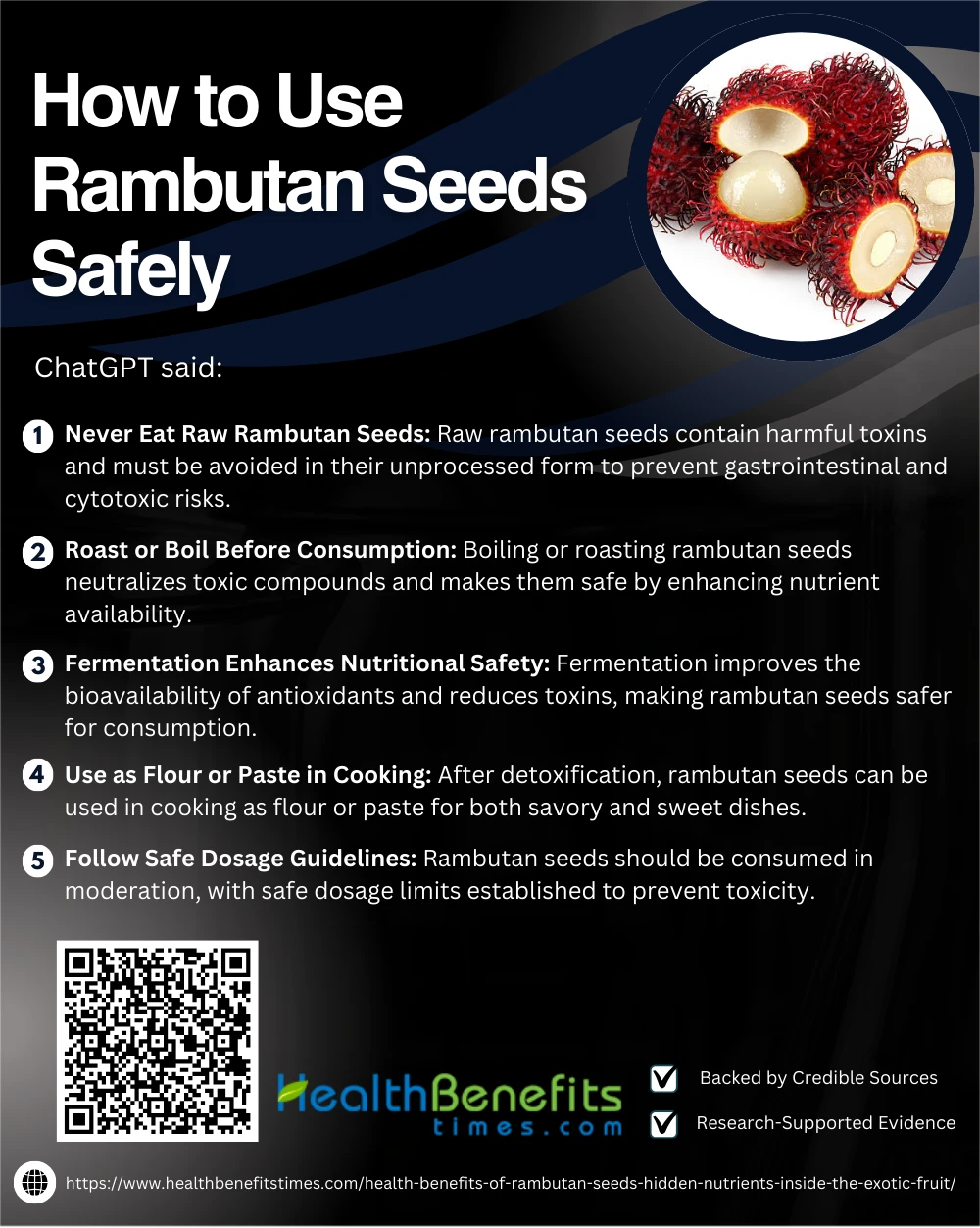 1. Never Eat Raw Rambutan Seeds
1. Never Eat Raw Rambutan Seeds
Raw rambutan seeds contain alkaloids, saponins, and other natural toxins that can be harmful when consumed without proper preparation. Studies confirm their potential toxicity in unprocessed form, highlighting risks like gastrointestinal irritation and cytotoxicity Dash et al., 2017, Handayani et al., 2021, Zamri et al., 2024, John et al., 2025, and Chai et al., 2019. (28) (23) (29) (30) Safe use requires boiling, roasting, or fermenting to neutralize these toxins before consumption.
2. Roast or Boil Before Consumption
Boiling or roasting rambutan seeds is essential to deactivate toxic compounds such as alkaloids and saponins. Heat processing significantly reduces their cytotoxicity and enhances fat bioavailability John et al., 2025. (23) Studies have shown that roasting improves nutrient retention and detoxification Febrianto, 2013, while boiling also promotes enzymatic breakdown of anti-nutrients Chai et al., 2019. (30) (31) Safe culinary applications begin only after thermal treatment Dash et al., 2017, Shan et al., 2024. (28) (32)
3. Fermentation Enhances Nutritional Safety
Fermentation is a powerful detoxification process that enhances the bioavailability of antioxidants, increases phenolic content, and reduces toxic compounds in rambutan seeds. Solid-state and lactic acid fermentation have been shown to improve overall nutritional safety and antioxidant function John et al., 2025, Shahrajabian et al., 2022, and Wanapat et al., 2024. (23) (33) (21) These methods transform the seeds into safer, more functional ingredients suitable for food and nutraceutical applications.
4. Use as Flour or Paste in Cooking
Once detoxified by boiling or roasting, rambutan seeds can be ground into nutrient-rich flour or blended into paste for diverse culinary uses. Studies show they are effective in baking applications such as biscotti and pastry Diez et al., 2022. (34) Their high lipid and fiber profile also suits functional food innovation Mahmood et al., 2018. (2) Broader food product reviews affirm their adaptability in savory and sweet dishes Sundar et al., 2024. (5)
5. Follow Safe Dosage Guidelines
Though rich in nutrients, rambutan seeds should be consumed in moderate amounts due to potential toxicity in high doses. Toxicological evaluations recommend limiting intake to ≤5000 mg/kg body weight in humans Catubig et al., 2023. (35) Safe usage includes incorporating seed flour at ≤10% in food formulations Mahmood et al., 2018. (2) Acute oral tests confirm safety within regulated doses.
Potential Applications in Food and Wellness Industry
With their rich nutrient profile and bioactive compounds, rambutan seeds hold promise for the food and wellness industry, offering potential in functional foods, supplements, skincare products, and natural health remedies.
Rambutan seed flour contains 30–40% healthy fats, 8–12% fiber, and moderate protein, making it ideal for incorporation into functional foods like biscuits, energy bars, and gluten-free blends. Studies show that it enhances satiety and promotes gut health when included in baking and cereal formulations.
2. Cocoa Butter Substitute
Rambutan seed fat (RSF) closely mimics the texture, melting point, and fatty acid composition of cocoa butter, especially in oleic and stearic acids. This allows it to serve as an eco-friendly and cost-effective substitute in chocolate, confectionery, and cosmetics.
3. Nutraceutical & Dietary Supplements
Due to its antioxidant, antidiabetic, and anti-inflammatory compounds (e.g., ellagitannins, flavonoids), rambutan seed extracts are being used in capsules, powder sachets, and functional beverages targeting metabolic disorders, oxidative stress, and immune support.
4. Natural Cosmetic Ingredient
Rambutan seed oil is packed with emollient fatty acids and natural antioxidants, making it excellent for use in skin creams, serums, and lip balms. It improves skin hydration, reduces oxidative stress, and supports anti-aging effects in dermatological formulations.
5. Bioactive Beverage Additive
Rambutan seed extracts are being tested in nutritional drinks, especially fermented and plant-based milk products, as a way to deliver fiber, satiety-promoting compounds, and prebiotics for gut and metabolic health.
6. Biodegradable Packaging & Bioplastics
Rambutan seed polysaccharides have been explored as sustainable materials for biodegradable packaging films. Their binding capacity and antimicrobial traits also offer food preservation benefits, helping reduce plastic waste.
7. Prebiotic & Gut Health Supplement
The seed’s fiber and bioactives foster growth of beneficial gut bacteria and support intestinal health. Studies support its inclusion in synbiotic yogurts, capsules, and fiber powders to improve digestion and immune defense.
8. Chocolate & Dessert Innovations
The creamy, fat-rich profile of rambutan seed makes it suitable for gourmet use in chocolate spreads, truffle fillings, non-dairy creams, and even custards, especially for vegan and health-conscious consumers.
Who should avoid consuming them?
Despite their benefits, rambutan seeds may not be suitable for everyone. Individuals with allergies, pregnant or breastfeeding women, and children should avoid them due to potential toxicity and insufficient safety data.
Children should avoid rambutan seeds due to the presence of alkaloids, saponins, and phenolic compounds that can cause gastrointestinal and neurological symptoms if ingested in raw or unprocessed form. These naturally occurring toxins are particularly harmful to young, developing systems. Studies confirm toxicity concerns and recommend avoidance unless thoroughly detoxified Handayani et al., 2021, Zamri et al., 2024, Kamaruddin et al., 2020. (29) (36)
2. Pregnant and Breastfeeding Women
Pregnant and breastfeeding women are advised to avoid rambutan seeds due to their content of alkaloids, saponins, and phenolic compounds, which may pose toxicological risks to fetal and infant development. Studies have demonstrated cytotoxic effects and potential mutagenicity from such compounds during sensitive physiological stages Handayani et al., 2021, Azizah et al., 2019, and Petheram, 2007. (37) (38) Proper scientific validation for safe intake during pregnancy is still lacking.
3. People with Liver or Kidney Disorders
Individuals with liver or kidney disorders should avoid rambutan seeds due to their content of alkaloids, phenolic compounds, and tannins, which may exert stress on detoxification pathways. These compounds can accumulate and potentially impair hepatic or renal functions if consumed in high or improperly prepared amounts. Research has highlighted possible toxicological impacts on these organs Dash et al., 2017, Handayani et al., 2021, Tripathi et al., 2021. (28) (6)
4. Individuals with Allergies to Tree Nuts
People with tree nut allergies should avoid rambutan seeds due to potential cross-reactivity of allergens. Clinical studies have identified rambutan proteins that mimic major allergens found in nuts like cashews and almonds, potentially triggering serious reactions Ruethers et al., 2019. (39) Case reports even link rambutan intake to anaphylactic responses in sensitive individuals Asam et al., 2017. (40) Immunological overlaps have also been documented in nut-allergic patients after consuming rambutan Ocampo & Rans, 2015. (41)
5. People Who Consume Raw or Unprocessed Seeds
Rambutan seeds should never be eaten raw due to the presence of alkaloids, saponins, and tannins, which are toxic in unprocessed form and may lead to nausea, vomiting, or worse symptoms. Toxicological research strongly advises heat treatment like boiling or roasting to reduce their antinutrient content Mahmood et al., 2018, Kamaruddin et al., 2020, and Dash et al., 2017. (2) (36) (28)
Side effects of consuming Rambutan Seeds
Consuming rambutan seeds improperly can lead to side effects such as nausea, vomiting, or toxicity. This is mainly due to harmful compounds present in raw seeds, emphasizing the need for proper preparation.
Consuming raw or inadequately processed rambutan seeds may cause gastrointestinal distress, including nausea, vomiting, diarrhea, and abdominal cramps. These effects stem from the presence of alkaloids and saponins, which irritate the digestive tract and disrupt normal gastrointestinal function. Scientific assessments confirm these risks, emphasizing the need for proper preparation before consumption Sundar et al., 2024, Zamri et al., 2024. (5) (29)
2. Liver and Kidney Stress
Rambutan seeds contain phenolic compounds, alkaloids, and saponins that may exert stress on detoxification pathways, leading to hepatic and renal strain, particularly in sensitive or immunocompromised individuals. Toxicological studies suggest that excessive or raw intake may impair liver enzyme balance and kidney function Tripathi et al., 2021, Dash et al., 2017. (6) (28) These findings support the importance of detoxification methods like roasting or fermentation before any dietary inclusion.
3. Nutrient Malabsorption
Rambutan seeds contain anti-nutritional compounds such as saponins, tannins, and phytates, which can bind essential minerals like iron, zinc, and calcium, leading to reduced nutrient absorption. Studies indicate that these compounds interfere with digestive enzyme activity and inhibit mineral bioavailability, especially when consumed raw or in excess Mahmood et al., 2018, Dash et al., 2017. (2) (28) Proper heat or fermentation treatment can help reduce these risks.
4. Potential Mutagenicity
Certain phenolic compounds found in rambutan seeds may exhibit mutagenic and cytotoxic effects, especially when consumed in unprocessed forms or high doses. These compounds can interact with DNA and cellular membranes, raising concerns about genotoxicity. Laboratory analyses have demonstrated potential risks to peripheral blood mononuclear cells Chunglok et al., 2014 and oxidative DNA damage in vitro Akter & Rabeta, 2021. (42) (22) Therefore, thorough detoxification via heat or fermentation is essential to minimize mutagenic risks.
5. Bitter or Astringent Reactions
Rambutan seeds may cause bitter or astringent taste sensations when consumed raw or underprocessed due to their high content of polyphenols and tannins. These compounds interact with salivary proteins, producing an unpleasant mouthfeel and bitterness that can lead to oral irritation Kamaruddin et al., 2020, Mehdizadeh, 2015. (43) (44) Proper roasting significantly reduces these sensory drawbacks, improving palatability.
Conclusion
Rambutan seeds, often discarded as waste, are a hidden treasure trove of nutrients and potential health benefits. Rich in healthy fats, antioxidants, fiber, and bioactive compounds, they may support heart health, improve digestion, and help regulate blood sugar levels. While their benefits are promising, it’s essential to consume them safely, as raw seeds can contain harmful substances. Proper preparation through boiling or roasting can unlock their nutritional value without the risks. As research continues, rambutan seeds could play a growing role in the food and wellness industry. Embracing such underutilized parts of fruits encourages sustainable and health-conscious eating habits.


